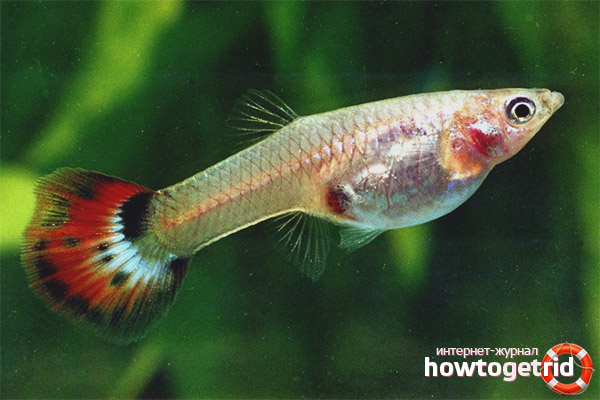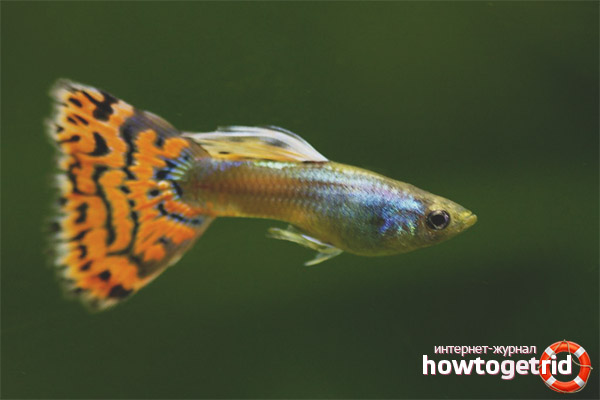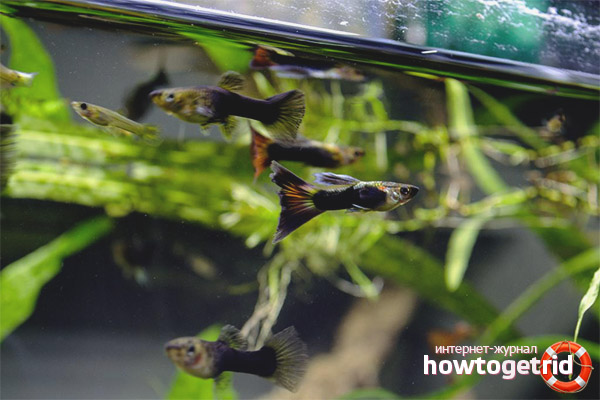The content of the article
A guppy is a small translucent aquarium fish that has long been known to all aquarists. Representatives of this family contain in flocks. Fish do not mark spawn, they are viviparous, so sharing or aggressive individuals in the aquarium is highly undesirable. Otherwise, you simply will not get offspring, because all the fry will be perceived as live food. Today we look at everything that affects the care, as well as the content of these nondescript inhabitants.
Description
- Guppies prefer to settle in Brazil, South America, and also on the islands of Tobago and Trinidad. These named places are considered the birthplace of guppies. They prefer clear, purified water.
- They can live in brackish springs, but not too saline, like sea water. By natural features, moths, larvae, worms, as well as small insects that fall into the water are eaten.
- Due to the ability to eat mosquitoes, guppies artificially began to be moved into the habitats of anopheles mosquitoes, because the fish eat their larvae. By their characteristics, male guppies are bright, females are more inconspicuous and large.
- The color of these fish is the result of the works of the discoverers, who were to create inhabitants as close in color as possible to the natural biotope. Often, the fish become victims, they need to hide.
- As for the dimensions, we have already mentioned. The females are large, the males are smaller. Along their length can reach 4-5 cm, but this is rare. The average life of small aquatic pets hardly exceeds 3 years.
- It is difficult to describe the appearance of these representatives. Since guppies have been used for a long time in breeding and creating new species, their color and body shape cannot be described. There are individuals that are completely different from each other.
- Fish breathe the oxygen that is in the water. They lack the atmospheric air, so a guppy needs a carefully prepared aquarium. It is important to install filtration and aeration.
- Many are interested in what the maximum period can live these fish.Due to the fact that they love warm water, all metabolic processes are accelerated. Fish die quickly. Therefore, the duration of existence depends on the indicators of water. The higher the temperature, the shorter the life.
Is it difficult to contain guppies?
- Fish is suitable for keeping in aquarium conditions for beginners. It is small, moderately active, does not require special preparatory measures for reproduction and care. It would seem that the list of positive qualities can be continued for a very long time.
- However, it is important to know that not all guppies are so easily kept at home. It is important in the process of buying to choose the right option. If all the fish, as a blueprint, then they should be abandoned. To identify breeding fish, you need to carefully examine them. If they look the same as clones, and even the fins of a single shape, then these pets will be difficult to care for.
- In cases where all the fish are somehow different, it means that they naturally came into the world and will feel great in the aquarium. It is important that the representatives of the family have a completely different color, body shape and fins in particular.
- Such difficulties are caused by serious crossing, which is why pets become more beautiful (possible), but also lose their immunity. They are sensitive to changes in water and its quality, they react negatively to vegetation, etc.
- Therefore, if you only try yourself as an aquarist, get the most simple and different guppies. Such fish are no worse than pets bred by multiple crosses.
Feeding
- Guppies are unpretentious in the diet, they do not require gourmet food. Usually, adults are fed dry, frozen or live food. The fry eat the same ground feed. You can choose food in the form of flakes, granular composition or other varieties. As for live food, they usually give a pipe worker, a bloodworm, a chopper, artemia.
- It is worth remembering forever that these members of the water family have a small oral cavity, the same can be said about the stomach. Therefore, it is necessary to feed the fish often, but in small portions. Usually, food is given three times a day, for one meal at a guppy should take 3 minutes maximum.
- Guppies have poor motility of the digestive system, therefore, products with high concentrations of plant compounds should also be given. Twice a week are given such foods that are saturated with vitamins and all necessary.
- It is necessary to allocate in a separate order dry food. Let's take daphnia, which is sold by weight in stores and markets. Such food is given no more than once a week, because in its essence daphnia is only dry shells. In moderation, they are useful, but in large quantities can significantly harm.
- If you feed your little guests three times a day, and one of the meals remains uneaten or the fish do not eat it completely, then the feeding needs to be changed. Give the fish food twice a day in the same portions. Try to feed the guppies at the same time so that they get used and not be in search of food. Otherwise, these fish will eat their fry.
Compatibility
- Fish does not cause trouble to the neighborhood, has a good-natured temperament. You can not sit down to her representatives of the water family, who are famous for their predatory instincts. Guppies are constantly perceived as food, so the choice of roommates come with great responsibility.
- You also can not choose as neighbors those fish that bite off the fins. This category includes kissing gourami, Indian knives, fire barbs, etc.
- Best of all guppies get along with congo, neonchik, rassam, catfish, cardinals and other small fish. Because they are conflict-free, problem-free.
- In some aquariums you can find catfish that live safely in the vicinity of guppies. From catfish choose small members of the family, because the big ones are predators. The exception is tarakatum, he will get along with these pets without eating them in two accounts.
Content
- Fish are tropical species that prefer to swim in warm water. Temperature regime should not exceed 22-25 degrees, this is enough for fish. However, in nature, pets live at 19-29 degrees, which negatively affects the duration of existence. In hot water, fish die quickly, and in cold water they become ill.
- For non-selective guppies, the parameters of the aquatic environment are not of fundamental importance. They quickly adapt to vibrations, so they easily transfer movement from one tank to another. Adhere to the rigidity indicators in the range of 12-18 units, and acidity - 7-8.5 units. However, the parameters may differ, it will not prevent the guppy from multiplying.
- One more positive feature of this type of fish is considered to be unpretentious in terms of tank volume. They need 20 liters. on 5 individuals. That is, 4 liters. for one fish. However, these pets love to swim, so any additional space for maneuver will be perceived positively.
- Fishes do not always need plants; by nature, guppies swim in dark places. Light is necessary for the plants in the reservoir so that they do not hurt. Plant the aquarium with plants, because they will create the necessary shade. At the same time, take care of the diffusing lamps so that the vegetation does not die.
- If there is an external filter in use, the guppy will do it. But with a small number of individuals in the aquarium, the fish feel great with an internal filter equipped with a sponge. If the filtering mechanism is powerful, then cover the holes in it with a net so that the fish do not overtighten.
- It makes no sense to contain guppies in the number of a pair of individuals, and even more so one by one. It looks sad, the aquatic inhabitants are practically not visible among the vegetation and shelters. They look beautiful in packs, so buy a lot of fish at once.
- The aquarium environment must be arranged in such a way that it has shelters. Because guppies will not survive without it, especially fry.
How to distinguish male from female
- Sex differences of the examined individuals are obvious. It is for this reason that you will not have any difficulties with this.
- Males are much smaller than females. They also differ noticeably slim. In males you can see a large tail fin.
- The females of the species under consideration are rather large. They have a fairly large and rounded belly. Also, females have a less bright color.
- Even younger individuals can already be distinguished. It's pretty obvious. Fry, which earlier began to acquire a brighter color, grow males.
Breeding
- The represented individuals reproduce without any problems in the aquarium. You do not even need to create special conditions. Breeding will be very simple. Guppies are viviparous representatives of the water world.
- After birth, the fry immediately swim at home. In rare cases, young animals appear in the aquarium in the egg.The fry immediately breaks it and begins to exist independently. The bottom line is that the female is carrying caviar inside herself. Then viable fry are born.
- Literally a few hours later, the young begin to feed on their own. Up to this point they will hide and adapt. In order to start breeding such fish, you just need a male with a female. More from you do not need anything.
- Breeders recommend planting several females on one male. However, there are no problems at all. In this case, the dilution will be more than successful. If desired, more males are allowed to start. Same-sex individuals do not fight among themselves.
- Do not panic ahead of time if you notice that the male tirelessly pursues the female. This behavior is considered normal. This can be characterized by the fact that the male fertilizes the female. Just be aware that soon in the aquarium will be young.
- To make the fish feel as comfortable as possible, it is necessary to provide them with clean and fresh water. Also, in a favorable environment, reproduction will be better. During such a period it is especially important to provide individuals with abundant and high-quality feeding.
- For breeding will require heterosexual individuals.At the same time, the representatives under consideration do not even need to be transplanted into a separate aquarium. They reproduce well in total capacity. Only here there are subtleties. Malkov will eat all and sundry. Even parents eat their own offspring.
- To prevent this from happening, it is recommended that the pregnant individual be transplanted into a separate container for a while. If you do not know how to determine the pregnancy of the female or when she is going to give birth, you need to rely on some facts.
- As a rule, females produce fry once a month. In addition, the timing can vary greatly. The reason for this may be different conditions of detention and water temperature. You need to remember the moment when the female last gave birth. After that, periodically observe the individuals.
- The female, which will be preparing for new genera, will darken the spot. Thus begin to see the eyes of the fry. Each time the stain will darken stronger. Be prepared for the fact that the female will soon be born.
- Your task is to transfer the female to a separate aquarium. Keep in mind that the conditions in the tank should be exactly the same as in the general aquarium.Fry should easily hide in the algae and feel safe.
- After the female gives birth, transplant it into a common aquarium, if this is not done, she can eat her own offspring. The content of fry is practically no different from adult individuals. Feeding the young stock is allowed by the chopped feed that you gave to your parents.
- Breeders, of course, recommend to buy a special feed for fry or dried egg. This food is a dried Cyclops and Daphnia. Product without any problems can be purchased at any pet store.
- In addition, in the aquarium in young animals often need to clean up. Otherwise, waste from fish and feed will quickly muddy water. Alternatively, it is allowed to run to the snail fry. Individuals will not conflict with each other. In turn, the snails will clean the aquarium.
- Consider, the water from fry should always be clean. Only here there are subtleties. It is forbidden to replace a large amount of liquid at once. Such conditions can be dangerous for the young body of the young. Maintain water temperature within 25 degrees.
Guppies are one of the most common aquarium fish. It is very simple to keep such individuals in total capacity with other representatives of the water world. When breeding is recommended to use a separate aquarium. To individuals lived comfortably and for a long time, try to provide the most comfortable conditions.
Video: Guppy Aquarium Fish














To send